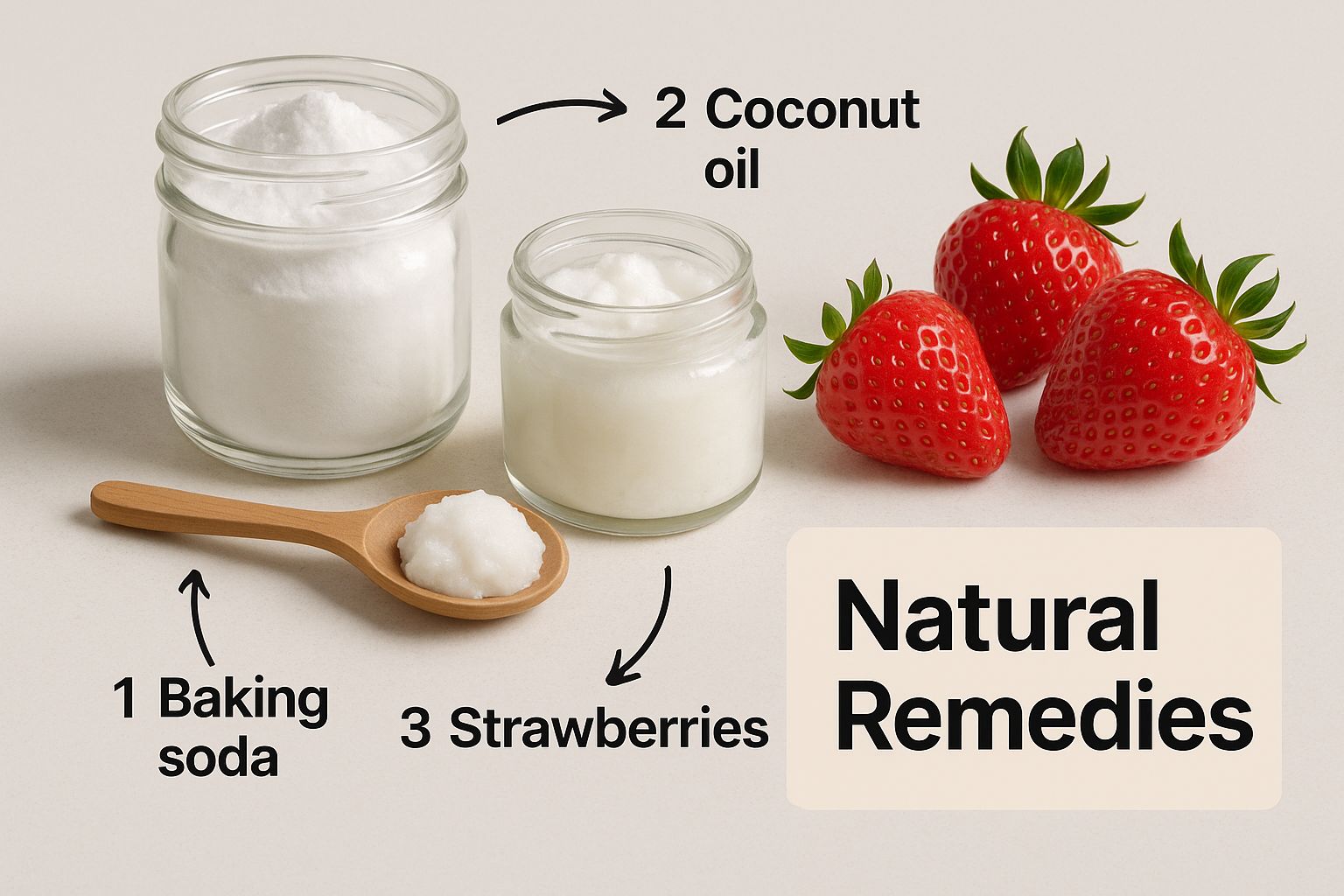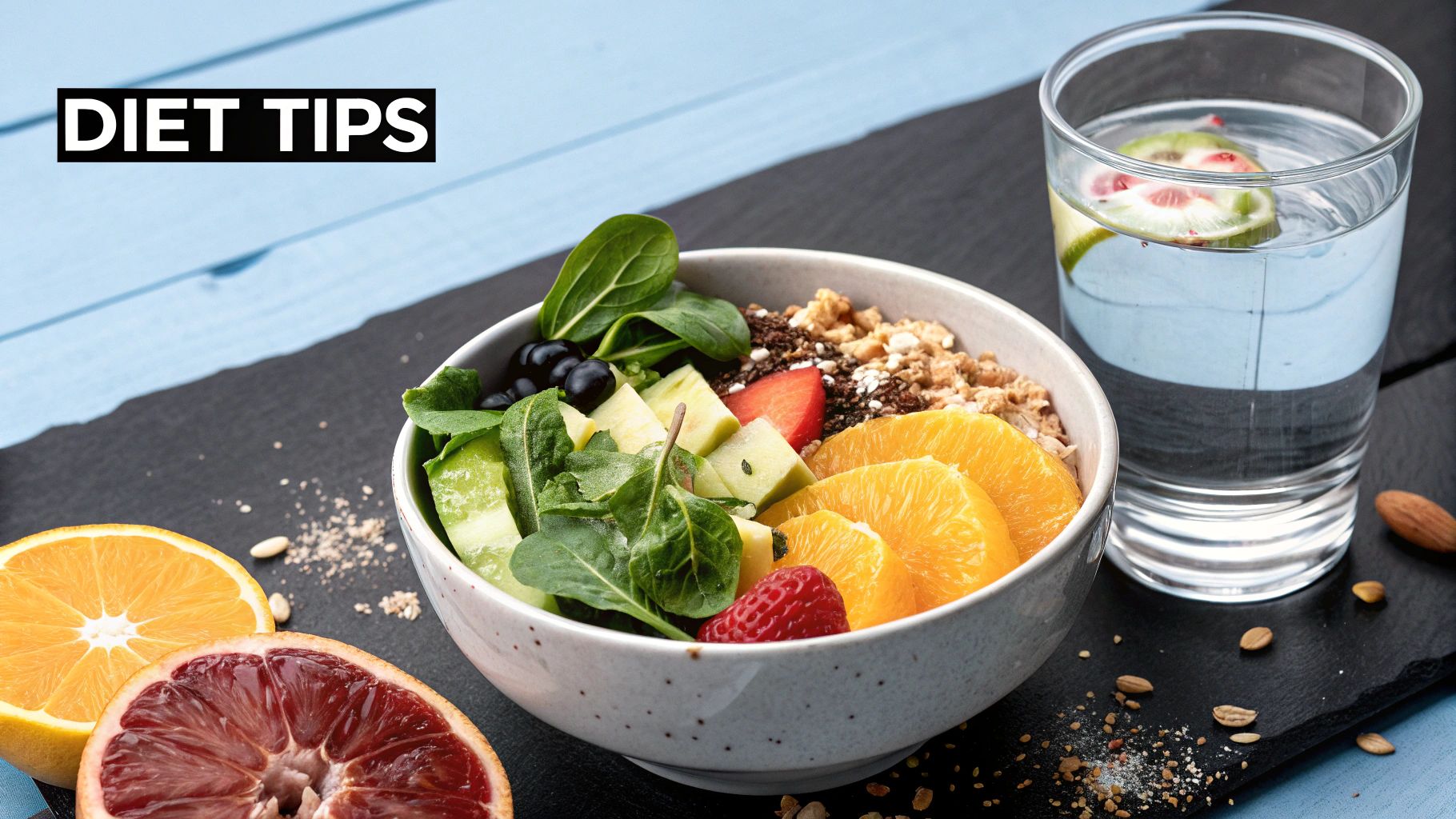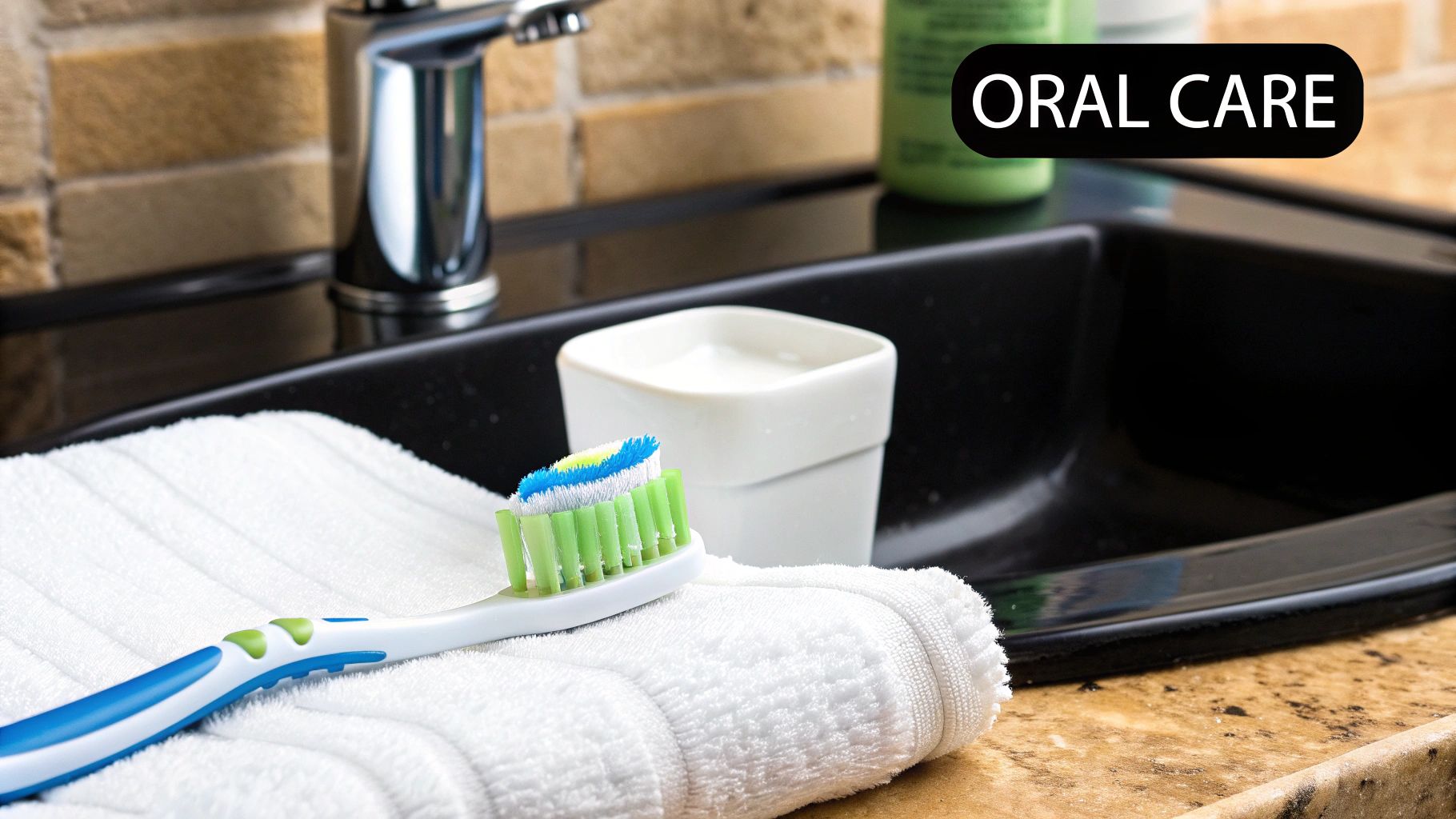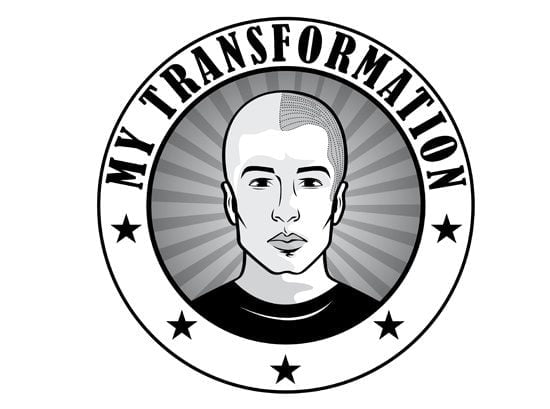
How to Whiten Teeth Naturally: Brighten Your Smile Today
Share
Before you can get that brighter smile, it helps to understand what makes teeth lose their sparkle in the first place. It's not just one thing. Discolouration is usually a mix of what we eat and drink, and deeper changes happening inside the tooth itself.
Knowing whether you’re dealing with surface stains or something more is the key to picking a whitening method that will actually work for you.
What's Really Behind Tooth Discolouration?
Have you ever looked in the mirror and wondered why your teeth seem a little duller than they used to? The truth is, it's a gradual process caused by a combination of your daily habits, your genetics, and simply getting older.
Most of us are dealing with what are known as extrinsic stains. These are the ones that build up on the surface of your enamel—the hard, outer layer of your teeth. Imagine spilling a bit of coffee on a white benchtop; if you don't wipe it up quickly, it starts to sink in. The same thing happens with your teeth.
Your Daily Habits Make a Difference
What you eat and drink every day plays a huge role in the colour of your smile. The biggest offenders are usually dark-coloured foods and drinks that are packed with strong pigments and acids.
- Coffee and Tea: Your morning ritual might be to blame. Both drinks are full of tannins, which are well-known for leaving behind stubborn brown or yellow stains on your enamel.
- Red Wine: With its deep colour and high acidity, red wine is a double-edged sword. It not only stains but can also slightly weaken the enamel, making it easier for future stains to stick.
- Dark Sauces: Think about things like soy sauce, rich tomato sauces, and balsamic vinegar. They can all leave their mark over time.
Even some super-healthy foods, like vibrant blueberries and blackberries, can contribute to staining because of their intense natural pigments. If you're consistently eating these things without rinsing or brushing afterwards, those stains have a chance to set in.
When the Problem is Deeper
Sometimes, the discolouration isn't just on the surface. Intrinsic discolouration is when the inner part of your tooth, the dentin, starts to yellow or darken. Your dentin has a naturally yellowish hue to begin with.
As we age, our enamel slowly thins out. This is a completely natural process, but it allows more of that yellowish dentin to show through. It’s one of the main reasons teeth look less white as the years go by, even if you have a perfect diet.
Genetics also come into play. Some people are just born with naturally brighter or thicker enamel. On top of that, things like an injury to a tooth or taking certain antibiotics during childhood can change the tooth's structure from the inside out, leading to deep discolouration that most natural whitening methods won't be able to fix.
7 Safe and Effective Natural Teeth Whitening Methods
If you're curious about brightening your smile without heading straight for professional treatments, you're not alone. There are several popular, gentle methods you can try at home. The secret is knowing how they work and, more importantly, how to use them safely to protect your precious tooth enamel.
These approaches are all about gradually lifting surface stains, not delivering the dramatic bleaching results you'd get from a dentist.

As you can see, many of these natural whitening techniques start with ingredients you probably already have in your kitchen, like baking soda, coconut oil, and even strawberries.
Using Baking Soda Correctly
Baking soda is a classic for a reason. Its effectiveness comes from being a very mild abrasive, which helps to gently scrub away the surface stains that build up from things like coffee, tea, and red wine. Think of it as a light exfoliant for your smile.
To give it a go, just mix a tiny amount of baking soda with a few drops of water until it forms a thin paste. Gently brush this onto your teeth for about a minute. The key is to do this sparingly—no more than twice a week—to avoid damaging your enamel over time.
The Power of Oil Pulling
Oil pulling is an ancient Ayurvedic practice that’s gained a lot of modern attention. While it doesn't bleach your teeth in the traditional sense, using coconut oil can help reduce the plaque and bacteria that make teeth appear yellow and dull.
Here's the routine:
- Start with one tablespoon of high-quality coconut oil.
- Swish it around your mouth for 15-20 minutes, making sure to pull it between your teeth.
- When you're done, spit the oil into the bin, never the sink. It can solidify and cause major plumbing clogs!
- Finish by rinsing your mouth well with water and brushing your teeth like normal.
Oil pulling is more about improving your overall oral health, which naturally leads to a brighter-looking smile. It’s a long-term commitment, not a quick fix.
What About Fruits and Acids?
You might have heard about using fruits like strawberries to whiten teeth. This is because they contain malic acid, an enzyme that can help break down some surface discolouration. A common DIY recipe involves mashing a strawberry and mixing it with a pinch of baking soda to create a paste.
You have to be extremely careful with this one, though. The combination of fruit acid and the abrasive baking soda can be quite harsh on your enamel if you overdo it. If you want to try it, use it very sparingly—once a month at the absolute most—and always rinse thoroughly and brush with regular toothpaste afterwards.
To give you a clearer picture, here’s a quick comparison of these popular at-home methods.
Natural Whitening Methods At a Glance
| Method | How It Works | Recommended Frequency | Safety Note |
|---|---|---|---|
| Baking Soda Paste | Mild abrasive gently scrubs away surface stains. | 1-2 times per week | Overuse can erode tooth enamel. |
| Oil Pulling | Reduces plaque and bacteria, which can cause yellowing. | Daily, for 15-20 mins | Spit oil in the bin to avoid clogging pipes. |
| Strawberry Paste | Malic acid helps break down surface stains. | Once per month (max) | Acidic and can be harsh on enamel; use with caution. |
While these natural options can offer a subtle lift, it's crucial to have realistic expectations. They can't match the results of professional treatments.
It’s also important to remember that professional-grade products are regulated for a reason. Here in Australia, there are strict rules around the use of bleaching agents like hydrogen peroxide, ensuring they are used safely and effectively. For deeper insight into these standards, the University of Sydney provides a great breakdown of teeth whitening regulations.
Ultimately, if you’re looking for more noticeable and reliable results, professional options are the way to go. Exploring professional teeth whitening in Perth ensures you get a faster, more dramatic outcome under the guidance of an expert.
DIY Whitening Trends That Can Harm Your Teeth
 If you've spent any time online searching for ways to whiten your teeth naturally, you’ve probably seen some pretty tempting "hacks." They pop up everywhere, promising a dazzling smile using things you already have in your kitchen. But before you jump on the latest viral trend, it's crucial to know that many of these quick fixes can do more harm than good.
If you've spent any time online searching for ways to whiten your teeth naturally, you’ve probably seen some pretty tempting "hacks." They pop up everywhere, promising a dazzling smile using things you already have in your kitchen. But before you jump on the latest viral trend, it's crucial to know that many of these quick fixes can do more harm than good.
The biggest issue with most of these methods is that they're either far too acidic or way too abrasive. They might seem to work at first, but they often put your tooth enamel—the hard, protective outer layer of your teeth—at serious risk. And here's the kicker: once your enamel is gone, it doesn't grow back.
The Dangers of Acidic "Whiteners"
One of the most common and damaging trends involves putting highly acidic ingredients directly on your teeth. Think swishing with apple cider vinegar or rubbing them with a lemon wedge. It makes some sense on the surface; the acid can lift some initial surface stains, making teeth look brighter for a moment.
Unfortunately, what's really happening is that the acid is dissolving your enamel.
When that protective shield wears down, it not only leads to painful sensitivity but also exposes the layer underneath, called dentin. Dentin is naturally a more yellowish colour, so eroding your enamel can ironically make your teeth look more yellow in the long run.
Using acidic ingredients like lemon juice is a surefire way to cause irreversible enamel erosion. The temporary brightening effect is not worth the long-term damage and increased sensitivity.
This isn't just a problem with homemade remedies. Research into Aussie whitening habits has revealed that even some store-bought kits can cause chemical burns and enamel damage if they aren't used correctly. You can understand more about Aussie teeth whitening habits and the risks involved.
Why Abrasive Scrubs Can Backfire
Another method that's gained a lot of traction is scrubbing your teeth with abrasive materials. Activated charcoal is probably the most famous example. It’s marketed as a natural powerhouse for drawing out stains, but the reality is that its gritty texture is just too harsh for your teeth.
Scrubbing with something as coarse as charcoal can create tiny, microscopic scratches all over your enamel. These scratches dull your teeth’s natural shine and, even worse, they give stains brand new places to settle and build up. The result? More discolouration down the track.
Be wary of any scrub that feels rough or gritty. Common ones to avoid include:
- Activated Charcoal: Its texture is simply too abrasive for safe, regular use on teeth.
- Harsh DIY Pastes: Any homemade paste made with coarse salt, bicarb soda, or other gritty ingredients can scratch your enamel.
Protecting your smile means sidestepping these risky shortcuts. The best and safest journey to a brighter smile is one that always puts the health of your teeth and gums first.
How to Keep Your Smile Naturally Bright

Getting that brighter smile is a fantastic feeling, but the real trick is making it last. The good news? You don't need to do anything drastic. Lasting brightness really comes down to the small, consistent habits you build into your everyday life to stop new stains from taking hold.
Think of it like protecting any other investment. You've put in the work to whiten your teeth, so a few clever adjustments will go a long way in keeping that smile looking its best.
Smart Daily Habits for Stain Prevention
The best defence is a good offence, and that means being proactive. One of the simplest yet most effective habits you can start today is rinsing your mouth with plain water right after having something known for staining.
Just finished your morning coffee, a glass of red wine, or some colourful berries? A quick 30-second swish with water can wash away those staining compounds before they have a chance to cling to your enamel. It's a tiny action, but over time, it makes a huge difference.
Of course, this doesn't replace the fundamentals. Your toothbrush and floss are still your most powerful allies in the fight for a naturally white smile.
Brushing twice a day and flossing daily is about more than just preventing cavities. This routine clears away the sticky plaque film that not only leads to decay but also gives teeth a dull, yellowish look.
Foods That Help Clean Your Teeth
It might sound surprising, but some foods can actually give you a helping hand in keeping your teeth bright. Snacking on crunchy fruits and vegetables can work like nature's own little toothbrushes.
Give these a try:
- Apples: Their fibrous, crisp texture gently scrubs your teeth with every bite.
- Carrots: Chewing on raw carrots gets your saliva flowing, which is your body’s natural mouthwash.
- Celery: Like carrots, its crunchy structure helps scrape away food particles and light plaque.
These foods physically scrub your teeth as you eat, making them a delicious and effortless way to support your oral hygiene. By weaving these simple, sustainable habits into your routine, you can keep your teeth looking their best long after any whitening treatment, ensuring your smile stays naturally brilliant.
Knowing When to See a Dental Professional
Learning how to whiten your teeth naturally at home can be incredibly rewarding, but it’s crucial to know where the line is between what you can safely do yourself and when you need to call in a professional.
Natural methods are brilliant for lifting surface-level stains—the kind that build up from coffee, tea, and everyday life. Think of them as polishing the exterior. But some discolouration goes much deeper.
If a stain is set deep within the tooth itself, no amount of gentle, external polishing is ever going to reach it. We call this intrinsic discolouration, and it can come from all sorts of things, like certain medications you took in the past, an old injury to a tooth, or sometimes, it's simply down to your genetics. These deep-set stains just won't shift with DIY approaches.
When Professional Advice Is a Must
Your oral health is a complete picture, and the colour of your teeth is just one part of it. If you're dealing with sensitivity, gum problems, or have had dental work done, chatting with your dentist before trying to whiten your teeth isn't just a good idea—it's a must for your own safety.
You should always get an expert opinion if you have:
- Sensitive teeth or gums: Even natural whiteners can sometimes make sensitivity worse, especially if there's an underlying cause that needs addressing first.
- Crowns, veneers, or fillings: These are made to match the colour of your teeth when they're put in. They won't change colour along with your natural enamel, which can lead to a mismatched look.
- Deep, stubborn stains: If you’ve been consistent with safe at-home methods and aren’t seeing any change, a dentist can figure out what’s really going on.
A dental professional can properly diagnose the reason for the discolouration and point you towards the safest, most effective treatment. It saves you from wasting time on things that won’t work and, more importantly, prevents any potential damage.
It's clear many Aussies are giving it a go. A 2022 survey revealed that while 22% of Australian adults have whitened their teeth, only about a third of them do it under professional supervision. If you're interested in the numbers, you can discover the full insights on Australian teeth whitening habits.
Seeing a dentist provides a controlled, safe path to a brighter smile. You can really see the kind of impact professional care can have by checking out a teeth whitening gallery of before-and-after results. At the end of the day, a quick professional chat ensures your journey to a whiter smile is not only successful but also completely safe.
Answering Your Questions About Natural Teeth Whitening
Thinking about whitening your teeth naturally is a great first step, but it usually opens up a whole host of questions. It's smart to get a handle on what to expect so you can set realistic goals and—most importantly—keep your smile safe along the way.
One of the first things everyone wants to know is, "how long will this actually take?" With natural methods, it’s all about patience. Unlike a one-off professional treatment, you're playing the long game here. Things like oil pulling or a gentle baking soda paste won't give you dramatic results overnight. Instead, you're looking for subtle, gradual improvements, often noticing a slight lift in brightness after a few consistent weeks.
That slower pace is actually a blessing in disguise, which brings us to another big question: the safety of it all.
Are These Methods Safe for My Enamel?
This is probably the most critical question to ask. The biggest risk with any whitening method—natural or not—is damaging your tooth enamel. This is the hard, protective outer layer of your teeth, and once it’s gone, it’s gone for good. That’s why you’ll see warnings against using highly acidic ingredients like straight lemon juice or abrasive scrubs, as they can literally wear away your enamel.
The trick is to stick with gentle, proven methods and never, ever overdo it. A fine powder like baking soda, for example, is generally considered safe for most people, but only when used sparingly. Think once or twice a week, maximum.
The main thing to remember is that "natural" doesn't automatically mean "safe." You have to listen to your teeth. Any new or increased sensitivity is a clear signal to stop what you're doing and rethink your approach.
If you already struggle with sensitivity, you have to be even more careful. We’ve put together some tips specifically on teeth whitening for sensitive teeth in our detailed guide.
Finally, people often ask if the results are permanent. Sadly, no teeth whitening lasts forever. Life happens! That morning coffee, a glass of red wine, or even certain sauces will eventually lead to new stains. Maintaining that brighter smile comes down to great oral hygiene and smart habits, like swishing with water after staining foods and drinks.
At My Transformation, we believe in helping you reach your aesthetic goals safely and effectively. Whether you're interested in teeth whitening or looking for solutions for hair loss, we're here to guide you. Discover your options at https://www.mytransformation.com.au.
